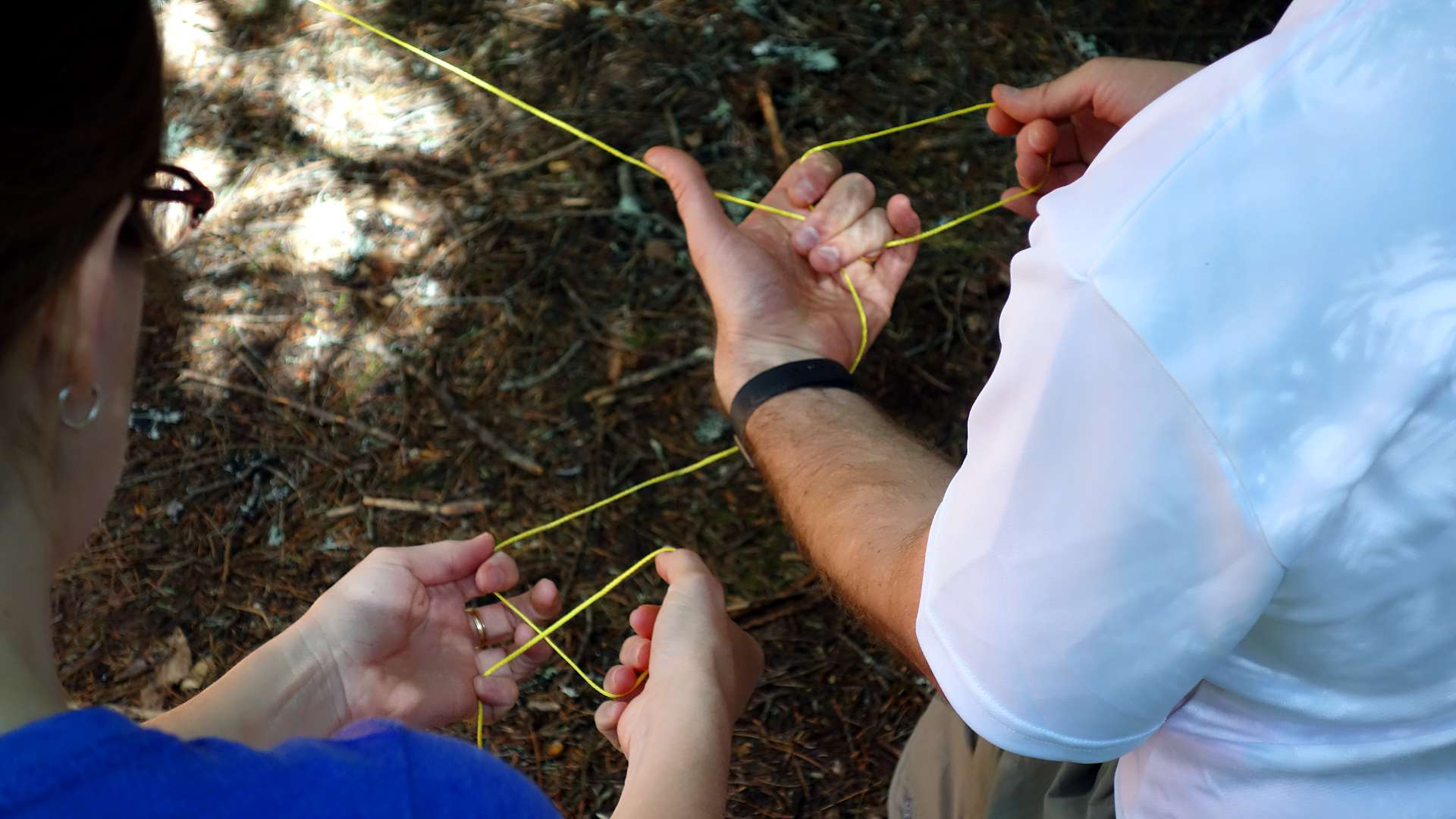Podcast: Download (Duration: 32:24 — 30.6MB)
Show Notes: Episode 121
Today on the First 40 Miles, ROPE: The Knot Episode. We’ll be extremely judicious with the knot puns and deliver some solid info on how to start incorporating these mathematical beauties into your outdoor adventures. For today’s SUMMIT Gear Review, a cheap way to get a whole lot of line that’ll keep your tarp from flying away. Next, on the Backpack Hack of the week, a quick way to mark your rope. And we’ll wrap up with a quote from some folks who wanted to tie our country together!
Opening
- Josh loves knots!
- Is it possible to go backpacking without knowing a single knot? Yep
- But as you progress, you might find it useful, even fun to learn a few knots. Knots seem useless and intimidating at first…
- The more you use it, the greater chance of remembering it.
- What are the qualities of a good knot? easily untied, does its job, doesn’t put stress on rope
- Every knot has its strengths and weaknesses—and some of that depends on what rope or cordage you’re using for your knot (string, cord, monofilament line, kernmantle rope, or nylon webbing)
- For example: The bowline is easy to tie and untie, however it can’t be untied with a load on it, and it doesn’t do well with slippery rope. And if you’re using the bowline to rescue an injured person, you have to use a stopper knot.
- Another popular knot that we probably all learned as “the friendship knot” is the square knot, it’s easy to learn however it’s prone to jamming, slipping under a heavy load…
- The sheepshank is a knot for shortening a long length of cord, but it really only works when there is constant tension on the two ends…otherwise it gets loose.
- For Beginners: http://scoutingmagazine.org/2016/04/tie-essential-scouting-knots/
- If you’re REALLY interests in knots: Check out The Ashley Book of Knots (the bible of knots) from your local library
- Weird knots…like the #1237 Girl Scout Hitch which involves rolling your stocking down, putting your finger under the roll, twisting several times and tucking the loop into the stocking.
- Another great knot book: Knots, Splices and Ropework by A Hyatt Verrill (who was the editor of Popular Science Department of American Boy Magazine), is free on Gutenberg.org http://www.gutenberg.org/files/13510/13510-h/13510-h.htm,
- http://www.animatedknots.com/ Which is awesome if you really can’t figure out knots by looking at a book…this provides step by step animation
- Knot tools or knot avoiders made by companies: Dutch Ware, LoopAlien, NiteIze
Top 5 Reasons You Should Learn a Few Knots
Knots are great for securing your gear
- Securing a tarp to some trees is probably the most common use of knots for backpackers. Sometimes we use the slip knot on one end and the tautline hitch on the other end, other times we use the truckers hitch to stake the ends down to the ground.
- Knots can secure your food when you hang it from a tree to protect it from animals
- One of the hammocks from Hennessy Hammocks that we borrowed from Jonathan at the Hang Your Own Hang Podcast relied on the double figure 8 knot to secure the hammock to the tree! We also used the Prusik hitch to attach out tarp to the ridge line over our hammock, so that the line or rope wouldn’t dig into the tarp and saw it in half
- Fishermen know the importance of a good knot. Without knots, fishermen wouldn’t catch anything…
Knots are great for repairing gear or fixing a problem
- With some rope and a secure knot, you can improvise a strap for a pack…
- It can even secure your pants and keep them from falling down as you hike.
- You can also tie a rope around your pack so you can hang your jacket, a secure knot means secure gear.
Knots make your rope more useful
- Knots preserve rope
- Knots make it so you can shorten a rope without cutting it, and lengthen it without being a magician
- Sheepshank knot can shorten it without scissors
Knots can rescue
- If you have a friend who has fallen, dangling some cord is a nice gesture, but it’s not going to help…
- But if you have some good cord—like basic 550 paracord or zing-it or lash-it , you can help. Even something as simple as knowing a stopper knot to tie to the end of your cord, can help
- There are all sorts of rescue knots that won’t slip, or that can be worn by the victim in ways that would be best for their rescue.
- Story of girl rescued by members of Mazamas Climbing Group and a clothing rope: http://www.kptv.com/story/29213041/hiker-falls-down-cliff-rescued-by-passers-by-with-clothing-rope-in-gorge
- A good rescue knot: http://www.animatedknots.com/indexrescue.php?LogoImage=LogoGrog.png&Website=www.animatedknots.com#ScrollPoint
Just knowing a few basic knots increases your confidence in the wilderness
- If you’re only armed with a granny knot, it limits how you can use your rope
- However, if you’ve downloaded a rope app, or memorized and practiced a few, you’ll be amazed at how many opportunities you’ll have to use your skills.
- JOSH: Favorite useful knots?
- HEATHER: Favorite useful knots?
SUMMIT Gear Review™: Braided Mason Line #18
- If you’re looking for something cheap and effective to throw in your pack so you can practice with knots on your next trip, braided mason line is a decent option
Structure
- If you’re familiar with paracord, we can use that as a reference…braided mason line is thinner than paracord
- Your hardware store will probably have two different kinds of mason line: twisted and braided. Get the braided. If you get the twisted, it will untwist—even if you melt the ends.
- Mason line is made of nylon, several different colors
- Comes in different weights, but you’ll want to get the 18 gauge braided mason line.
Utility
- Braided mason line has an approximate tensile strength of 155 pounds
- This rope isn’t going to be going to Everest, but it’s probably going to do what you need it to do while backpacking
- Abrasion resistant
- Fluorescent pink, fluorescent yellow, fluorescent green, white, so it’s easy to see
Mass
- Depends on length—much lighter than paracord, much thinner
- The heaviest part of the mason line is the cardboard center
- Cut what you need for your trip, and leave the rest at home
Maintenance
- Mason line resists moisture, dryness and mildew
- Check periodically for frays and nicks
- As with all gear, put it away dry
Investment
- Depending on the length (250-500 ft), you’ll find it for somewhere between $8-15
Trial
- We’ve brought it on several backpacking trips, and it’s held up under some very windy conditions—without snapping for fraying
- Recommend spooling it instead of just winding it…
- Cheap, Bright, Easy to find at Home Depot (our little local Ace hardware store only had the twisted mason line)
- If you’re looking for something that is stronger but just as petite, but has a 400 pound tensile strength…
- Beware: braided mason line can get knotted easily
Backpack Hack of the Week™: Striped Line
- To differentiate longer sections of rope from your shorter sections, just wrap the cord around your hand and draw lines with a sharpie across it so the line is zebra striped. Simple way to mark your rope!
Trail Wisdom
“We can tie this country together with threads of GREEN that everywhere grant us access to the natural world.”
–President’s Commission on Americans Outdoors

